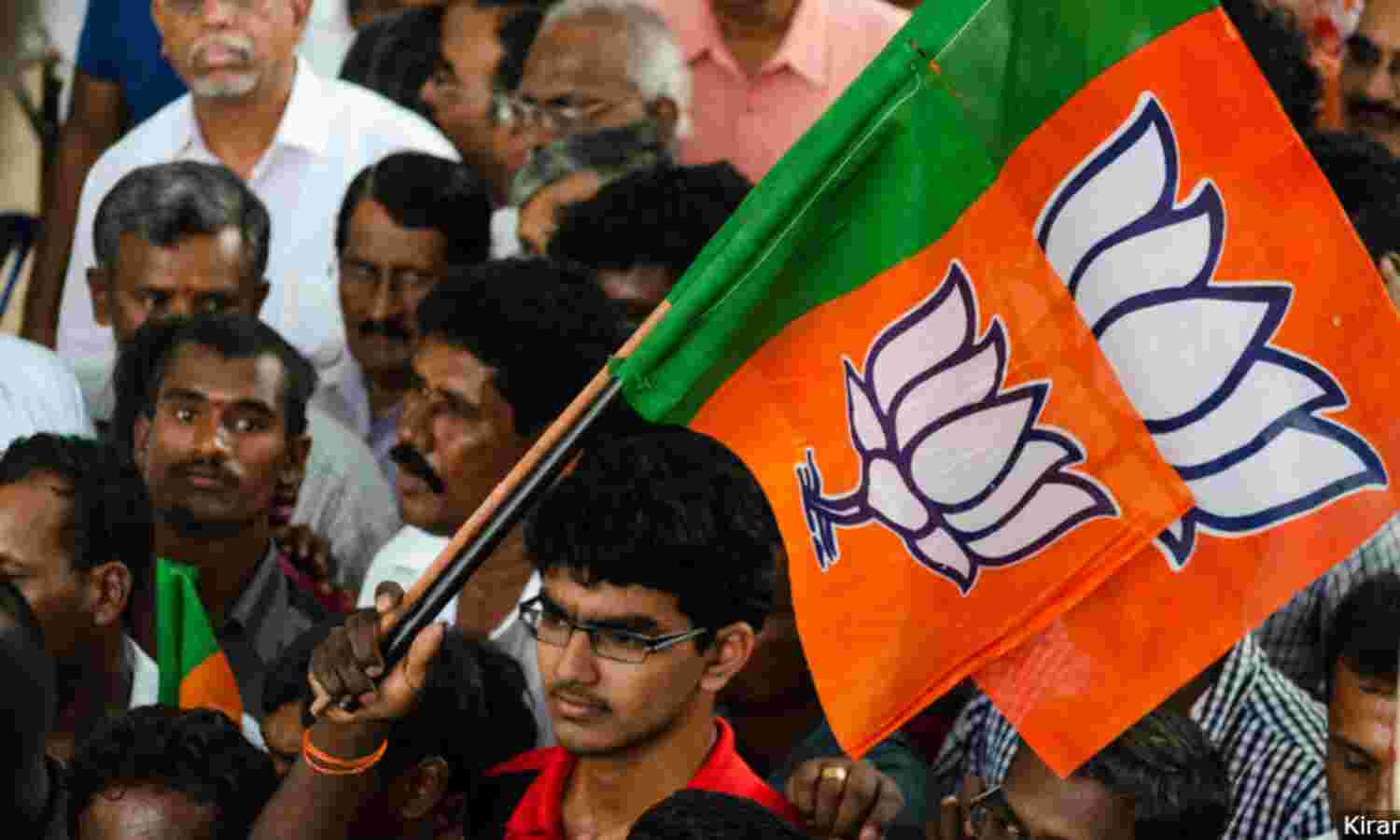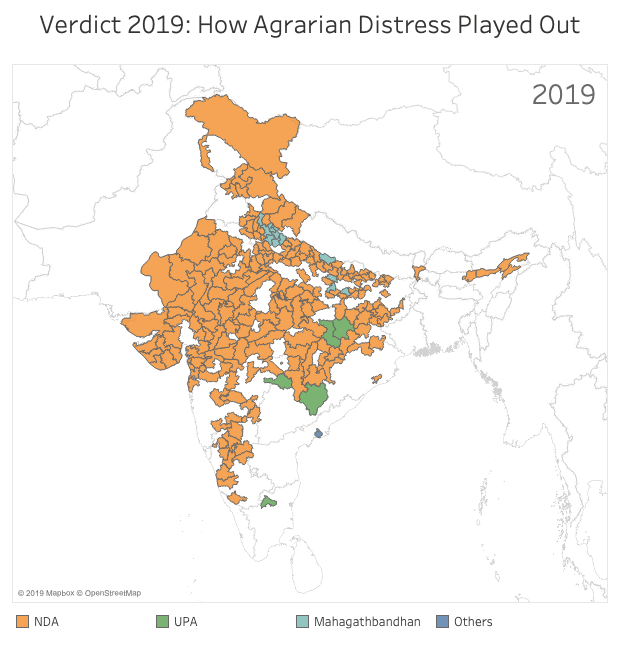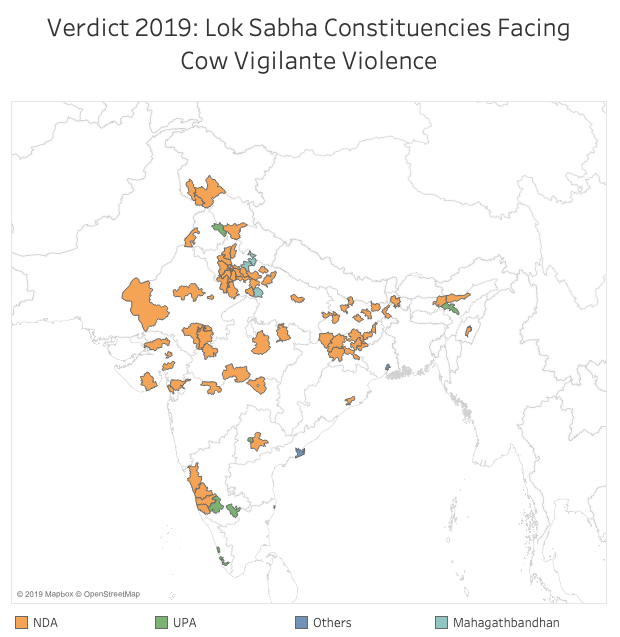India Votes For National Security Over Development, Governance

Mumbai: Having won 302 seats and leading in another one of 542 seats, 21 more than its seat share in 2014 (282), the Bharatiya Janata Party (BJP) has won the 2019 Lok Sabha elections.
The BJP was leading in all seats in 10 states and union territories: Arunachal Pradesh, Gujarat, Haryana, Himachal Pradesh, Tripura, Uttarakhand, Delhi, Daman & Diu, Chandigarh, and Andaman & Nicobar Islands, and has made further inroads into Maharashtra, Madhya Pradesh, West Bengal, Telangana and Odisha, as of 11.15 am on May 24, 2019.
In 2014, the BJP had won all seats in nine states and union territories: Gujarat, Rajasthan, Himachal Pradesh, Uttarakhand, Delhi, Daman & Diu, Dadra & Nagar Haveli, Chandigarh, and Andaman & Nicobar Islands.
The BJP’s emphasis on national security following the February 2019 surgical strikes across the Line of Control (the de-facto border between India and Pakistan) into Balakot, Pakistan, which fortified Prime Minister Narendra Modi’s image as a strong leader, as well as the party’s control of the narrative on development schemes seems to have led to the BJP’s historic victory, analysts told IndiaSpend.
The surgical strikes marked a turning point in the BJP’s campaign, giving it a talking point that would overtake the opposition’s attempts to focus on the incumbent party’s lacklustre showing on the economic, social and governance front, as evident from pre-election polls such as CSDS-Lokniti-The Hindu-Tiranga TV-Dainik Bhaskar’s Survey 2019.
As FactChecker’s evaluation of the government’s flagship programmes in the Modi Report Card series showed, many ambitious programmes--promising, among other things, housing for all, financial inclusion, free cooking gas connections to poor families, access to improved sanitation and rural electrification--widened access, but had shortcomings in implementation.
The results
Geographically, the BJP’s grip on the north-west of the country looks set to strengthen.
In the north, in Uttar Pradesh (UP), India’s bellwether state, the BJP has won nine fewer seats (62) than the 71 it had won in 2014; it has lost these to the Samajwadi Party (SP) and the Bahujan Samaj Party (BSP). It has maintained a majority, nevertheless.
“I do not think the SP-BSP or the Congress party presented a formidable alternative. The Congress’s old narrative of a secular government and that Modi can’t deliver on promises seems to have been weak,” Narayana A., professor of governance at Azim Premji University, told IndiaSpend. “In UP, the mahagathbandhan [grand alliance] was relying too much on caste calculations, which seems have fallen short of convincing the voter.”
In the east, the party has broken fresh ground in Odisha, a longstanding Biju Janata Dal (BJD) stronghold. The BJP has won seven seats and was leading in one, as of 11.15 am on May 24, 2019; it had won one seat in 2014.
The BJD is set to return to power in the state assembly--elections for which were held simultaneously with the general elections--having won 98 seats and leading in 14 seats as of 11.15 am on May 24, 2019. The state has a 146-member assembly.
Three other states held simultaneous state and general elections. In the 55-member Arunachal Pradesh assembly, the BJP has won 33 and leads in 1 seat, while the Congress has won 4.
In Sikkim, the state’s Sikkim Krantikari Morcha that turned down an alliance with the BJP ahead of the 2019 elections, has won 17 of the 32 seats.
In Andhra Pradesh, the Yuvajana Sramika Rythu Congress Party (YSRCP) has swept the 175-member assembly by winning 150 seats and leading in 1 seat as of 12.55 pm on May 24. In the general election, too, the YSRCP has won 21 of the 25 seats and is leading in one seat.
In West Bengal, the BJP has won a significant number of seats--18 of the 42--for the first time ever. Campaigning in the state had witnessed several reports (such as here and here) of violent clashes between the BJP and the All India Trinamool Congress, which is in power at the state level. The Trinamool has won 22 seats, down from 34 in 2014.
“In West Bengal it appears the votes for the Left party [Communist Party of India (Marxist)] have gone to the BJP,” Narayana said. “In Odisha, there may be anti-incumbency--even in the case of Naveen Patnaik, who is a strong regional leader--the electorate may still want change. This could be the case in the next elections for Modi, too.”
In the 2014 election, the All India Anna Dravida Munnetra Kazhagam (AIADMK), which has now allied with the BJP to form the National Democratic Alliance (NDA), had won 37 seats in Tamil Nadu. However, the south Indian regional party felt the absence of deceased party leader J. Jayalalithaa, as it could garner only one seat this time.
Most of the state’s 38 seats have gone to its rival Dravida Munnetra Kazhagam (DMK), which has secured 23 seats. The election in Vellore was deferred following the seizure of money ahead of polls in April 2019.
BJP presence in conflict-affected regions
In Jammu & Kashmir (J&K), the party has retained the three seats it had won in 2014.
In J&K in 2014, the BJP had allied with the People’s Democratic Party (PDP), which had won the remaining three seats to allow the NDA to claim the state. The Jammu & Kashmir National Conference has won these this time, ousting the PDP.
In insurgency-hit Chhattisgarh, the BJP has won nine seats--down from 10 in 2014. Chhattisgarh’s Bastar constituency in the south, which includes Maoist-hit areas such as Bastar, Dantewada, Narayanpur and Bijapur, has voted for the Congress this time, with a margin of 38,982 votes. In 2014, the BJP had won this seat with a margin of 124,359 votes.
In a continuing trend for the seven sister states of the northeast region, the BJP has managed to win 15 seats--seven more than the eight it secured in 2014.
Historically, the north-east part of India has been inclined to vote for the party running the central government. In part this is due to their heavy dependence on central grants and funds, but more recently, this is because support for the BJP and PM Modi after the 2014 election has been much greater than what the BJP enjoyed during its full term at the Centre between 1999 and 2014, according to this Mint report from March 17, 2017.
In Tripura, a former bastion of the CPI (M), the BJP has won both seats for the first time since the state was formed in 1972.
In 2018, the BJP, winning two seats in the assembly elections, formed government in the state through a coalition with the Indigenous Peoples’ Front of Tripura.
Surgical strikes
“The BJP essentially portrayed the national security issue to be a grave concern for India and this has worked for them in the elections,” Manoj Joshi of the Observer Research Foundation, told IndiaSpend. “After portraying the country to be under threat, Modi was shown to be a decisive, strong leader in securing the country.”
The BJP was looking for a “transcendental issue” of the kind that the Ram Mandir had been in the 1990s, and found it in the surgical strikes, Joshi said. “When the Pulwama terror attack happened, the BJP’s opportunistic response through the Balakot strikes became their central campaign and it worked, especially in the Hindi heartland--whatever one is hearing anecdotally about the strikes is what has captured the imagination of the voters--even in remote rural areas,” Joshi said.
It is crucial to understand that Balakot was a bilateral issue with Pakistan while Pulwama was the national issue, Suba Chandra, professor of International Strategic & Security Studies at the National Institute of Advanced Studies, told IndiaSpend. “Balakot not only changes the narrative in India but also that in Pakistan,” he said, “The problem with such a narrative is that if [another such] incident were to occur, there would be pressure on the government to respond militarily--we still do not know if this is in our strategic interest or not.”
“[The] Balakot [surgical strikes] may have helped the BJP consolidate the vote,” Narayana of the Azim Premji University told IndiaSpend, adding, “But the trends show that there is an undercurrent of support for the BJP based on the close contest we saw in the assembly elections in Gujarat, Rajasthan and Madhya Pradesh.”
“Earlier, the BJP spoke of Muslims in their narrative, but this time Muslims, Pakistan, terrorism, and national security formed a powerful election narrative,” Narayana said, “So the BJP has mobilised the voters around certain schemes such as PMAY [Pradhan Mantri Awas Yojana] and Ujjwala, even though they could not deliver on other promises. This seems to have provided a feeling that the BJP delivered.”
The rise of BJP in India seems consistent with what is happening around the world, said Uttara Sahasrabuddhe, professor and head, department of civics and politics, University of Mumbai. “Be it Modi, be it [US President Donald] Trump, these leaders are working more towards protectionist measures.”
These new leaders are using nationalism to fuel protectionist trade policies by portraying free trade as inimical to national sovereignty and the right to bring in protectionist policies as an expression of sovereignty. “Make In India is about protectionism,” she said, “So in a way [the strengthening position of the] BJP has been consistent with the trend that is been seen outside. In Europe and America, they are anti-migration--India’s citizenship registration bill is a similarly anti-migrant policy.”
Farm distress
Of the 282 constituencies the BJP won in 2014, IndiaSpend identified 206 with agrarian distress. Of these, the BJP has lost 25 and retained 181.
Farm distress featured prominently in opposition parties’ campaigns, which highlighted issues such as falling prices of agricultural produce, inability of the government to offer adequate procurement prices as promised, water shortages and farmer indebtedness and suicides (based on leads and results as of 11.15 am on May 24, 2019).

Note: Based on leads and results as of 11:15 am on May 24, 2019
Amid rising agrarian distress, thousands of farmers from nearly 200 organisations across the country had marched to Delhi in November 2018 to demand a special session of parliament to highlight these issues and demand a total farm loan waiver.
The share of agriculture in India’s economy dropped more than 5 percentage points to 12.2% over 12 years to 2016-17, Livemint reported on December 3, 2018. Yet, by most measures, agriculture and related activities continue to offer livelihood to more than 50% of Indians.
In Uttar Pradesh, where the BJP has won 62 seats, unpaid sugarcane dues in the western part of the state amounted to Rs 11,845 crore as of March 12, 2019, The Hindu Businessline reported on March 20, 2019. Of this, nearly 52% or Rs 6,168 crore was due to cultivators in Shamli (Kairana constituency), Saharanpur, Muzaffarnagar, Ghaziabad, Meerut, Baghpat and Bulandshahr. The BJP has won all these except Saharanpur.
About 42% of India’s land area is facing drought, with 6% exceptionally dry--four times the spatial extent of drought last year, IndiaSpend reported on April 3, 2019. The BJP has won all seats in the drought-affected areas of Bundelkhand in southern UP, the region which covers the parliamentary constituencies of Hamirpur, Banda, Jhansi and Jalaun--three of which were listed as drought-affected in 2018, as IndiaSpend reported on April 29, 2019.
In Madhya Pradesh, where 23 of 29 constituencies were identified for agriculture distress, the BJP has won all 23. About five months ago, the three-term incumbent BJP had lost the 2018 state assembly elections to the Congress, reportedly due to farmers’ disenchantment.
In Mandsaur, where police firing killed six farmers in June 2017, the BJP has not only retained its hold but has widened its winning margin by 376,734 votes.
In Maharashtra, the BJP has won 23 of 48 seats, and its ally Shiv Sena, 18. In Karnataka, the BJP has won 25 of 28 seats. This is its best performance in the two states since the party was formed in 1980. Maharashtra reported the most farmer/cultivator suicides (2,550, or seven every day) in 2016, followed by Karnataka (1,212), IndiaSpend reported on March 21, 2019.
In Beed, in the drought-prone Marathwada region of Maharashtra, which faced its worst drought of the century in 2015, the BJP has retained its seat, winning by a margin of 168,368 votes.
“I think handouts like PM-KISAN had an impact in some areas. It is possible that the BJP used all this to add to the narrative,” economist Jayati Ghosh told IndiaSpend.
“All governments had schemes, but they did not have a process for mobilising around the schemes like the BJP has done. The Congress, for example, did not weave a narrative around MGNREGA,” Narayana told IndiaSpend, referring to the Mahatma Gandhi National Rural Employment Guarantee Act, the world’s largest job-guarantee programme.
Sectarian violence
Of 83 constituencies IndiaSpend identified for reporting cow-related hate violence between 2014 and 2019, the BJP has won 63. In 2014, it had won 60 of these seats--based on leads and results as of 11.15 am on May 24, 2019.

Note: Based on leads and results as of 11:15 am on May 24, 2019
“The results reflect a major shift in our Indian society,” Ghosh said. “The campaign by the BJP was run on an openly communal, divise agenda. They promised a muscular state that would go after our neighbours and minorities which would impose a vision of the Hindu rashtra [nation]. It is worrying that a significant part of the electorate has decided to vote for the BJP despite their failure on the economic front and destruction of institutions.”
“Voters seem to be less driven by straightforward economic interests than by sectarian interests and cultural priorities,” observed economist Abhijit Banerjee along with Thomas Piketty and Amory Gethin, in a March 2019 paper.
“If voters come to believe that the state cannot offer anything useful in terms of economic benefits, then they will be responsive to sectarian claims. If people start caring about only sectarian issues, then parties have an incentive to promote it and then we will end up in a totally fractured polity,” Banerjee had told IndiaSpend in a May 15, 2019 in an interview.
“There should be more politics based on economic interests because those are aspects that we can deliver on without creating social divisions… they can often be addressed, whereas sectarian interests cannot be addressed other than saying that we will hurt those others, which is frightening,” Banerjee had said.
India must not be seen in isolation, Chandra of National Institute of Advanced Studies said. “There is a rise of right-wing nationalism across countries,” he said, “There is a serious crisis in the liberal democracies where they are unable to address issues of migration and violence. Ideally the Left should have stepped in, but it has failed. Under such circumstances, the right is filling the void.”
We welcome feedback. Please write to respond@indiaspend.org. We reserve the right to edit responses for language and grammar.


